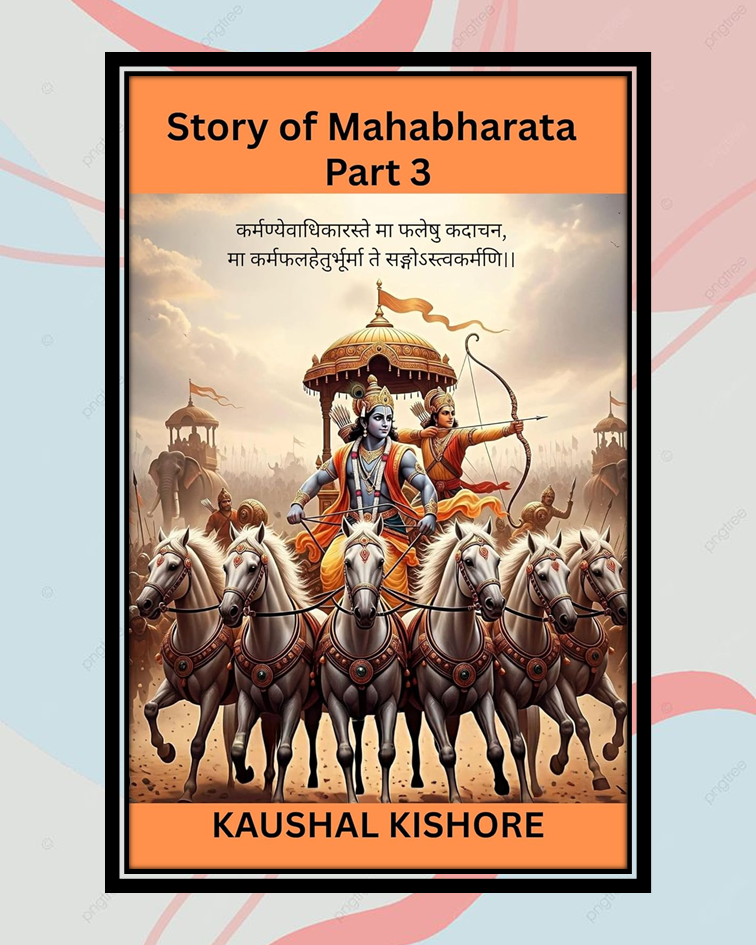Sameer Gudhate Presents the Book Review of The Story of Mahabharata: Part 3 by Kaushal Kishore
- Sameer Gudhate
- Oct 9
- 3 min read

There are stories that roar with grandeur, and there are stories that whisper eternal truths. The Story of Mahabharata: Part 3 by Kaushal Kishore somehow does both. I began reading it late one night — rain murmuring against the window, a faint aroma of chai lingering — and within minutes, I was no longer in my room but standing on the dusty plains of Kurukshetra. The conch shells had sounded, the sky trembled, and time itself seemed to pause. This wasn’t just a retelling; it was an invocation.
Kaushal Kishore is no stranger to mythology lovers. His previous volumes in the Ancient Stories from Puranas and Other Scriptures series have already built a quiet yet devoted readership. With this third and final part, he doesn’t merely conclude the Mahabharata — he completes a circle that began with Bhishma’s birth and ends with his final breath. What makes Kishore’s work so remarkable is not just his fidelity to Ved Vyasa’s original, but the tenderness with which he translates divinity and dilemma into language that feels utterly human.
This volume captures the tumultuous crescendo of the epic — the desperate attempts at peace, the stubborn pride that fuels destruction, and the war that becomes the world’s greatest moral mirror. Kishore writes with clarity that feels like conversation and reverence that feels like prayer. His prose doesn’t weigh you down with grandiosity; it draws you in gently, letting each scene unfold like a film on slow motion — the shimmer of arrows in sunlight, the silent tears of Gandhari, Krishna’s calm smile even as chaos reigns.
What struck me most was the way Kishore handles the greyness of characters. Bhishma, Drona, Karna, Arjuna — none of them wear the perfect white or black of morality. Instead, they are all cloaked in shades of silver and shadow, their choices echoing the same contradictions that inhabit us. Reading about Karna’s inner torment or Yudhishthira’s momentary confusion felt like watching fragments of our own humanity play out on an epic scale. Kishore reminds us that even gods and warriors were, at their core, beautifully flawed beings trying to do what they believed was right.
The structure of the book flows like the Ganga — steady, pure, and purposeful. Kishore resists the temptation of over-explaining. Instead, he summarizes with empathy, ensuring that even complex philosophical dialogues remain approachable. The pacing feels natural — serene in reflection, swift in action — mirroring the rhythm of the Mahabharata itself. I particularly admired how he captured Krishna’s divine strategies not as magical interventions, but as lessons in wisdom, foresight, and balance — the essence of dharma itself.
Beyond the blood and battles, what lingers is the ache of loss, the quiet after victory. Kishore doesn’t let readers escape into glory; he makes us sit with the cost of war. There’s a poignant moment when Bhishma, lying on his bed of arrows, speaks of life and duty. It’s as though time stands still. Kishore’s words here aren’t just a translation — they are a meditation.
Emotionally, the book moves in waves — moments of triumph followed by aching silence. I found myself closing the Kindle more than once, not because I wanted a break, but because I needed to breathe. The epic had found its way under my skin. It made me think about our own modern battlefields — offices, relationships, society — where righteousness and ego still wrestle every day. The Mahabharata, through Kishore’s lens, becomes a mirror we can’t look away from.
If I were to point out a limitation, it would only be that some readers might crave more commentary or interpretation. Kishore stays close to Vyasa’s spirit, allowing the story to speak for itself. But perhaps that’s the beauty of it — it respects the reader’s intelligence and emotional depth.
The Story of Mahabharata: Part 3 isn’t just a conclusion to a trilogy; it’s a doorway back into one of the world’s oldest conversations about what it means to be human. Kishore’s clear, heartfelt writing makes this timeless epic accessible without ever diluting its power.
If you’ve ever looked for a retelling that feels both sacred and relatable, scholarly yet soulful, this one deserves a place on your nightstand. When you turn the last page, don’t be surprised if you sit in silence for a while, feeling both the weight and warmth of the world within you. Because that’s what great stories do — they end, yet never really leave.
Read it. Not just for mythology, but for yourself — to rediscover the truth, the conflict, and the grace that live within us all.
#Mahabharata #StoryOfMahabharata #KaushalKishore #IndianMythology #EpicReads #MythologyLovers #AncientWisdom #VedVyasa #KrishnaStories #EpicStories #IndianEpics #MythologyBooks #BookReview #MustReadBooks #BookRecommendations #ReadersOfInstagram #BookLovers #StorytellingMagic #TimelessStories #LifeLessonsFromBooks #CharacterDrivenStories #EpicSaga #WisdomThroughStories #BookAddict #MythologyRetelling #sameergudhate #thebookreviewman







Comments